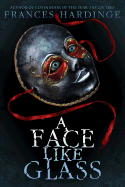Face like Glass by Frances Hardinge is completely original and imaginative to the poin t of near insanity. It’s the kind of fantasy that forces the brain to stretch and contort and stretch into brand new outlooks. It forces the consideration of brand new perspectives and possibilities.
t of near insanity. It’s the kind of fantasy that forces the brain to stretch and contort and stretch into brand new outlooks. It forces the consideration of brand new perspectives and possibilities.
When Master Grandible, a reclusive cheese artisan, discovers a lost child in Caverna’s highly secluded tunnels, he realizes immediately that the girl is different. Seeing an opportunity but also wishing to protect her, he takes her in, hides her strange expressive face behind a black velvet mask, and raises her as his apprentice. Weary of Caverna’s society, he barricades them in, dealing only with a select few through his well-defended door. Seven years later the girl, called Neverfell, follows a small white rabbit to a crack in her master’s domain and wanders out into the world of Caverna. Caverna’s inner city is beautifully detailed and immersive. The passages and caves are so convoluted that anyone who tries to map them goes mad. The elite families are at constant war with each other for control of the city, and for the favor of the Grand Steward. The Grand Steward is so obsessed with staying in control that he has artificially extended his life and cleaved himself into two beings so that one part of him will always be awake. The members of the elite class are trained in a wide array of facial expressions, each carefully donned for the greatest manipulative effect, while the commoners are not allowed to have visible emotion and must wear only five approved faces. In contrast, Neverfell wears her thoughts and feelings on her face and that is the most dangerous thing of all. But there are people that definitely finds such a thing to be useful and that is how Neverfull ends up becoming a pawn in a dangerous game of power.
The progression of this story follows Neverfell in a character arc that shows realistic, slow growth. For the first part of A Face Like Glass, Neverfell is nothing but a pawn being moved from side to side and things happen to her. But as she starts to interact with people and learn about the true facade of life in Caverna, the more she grows, changes and becomes an active participant not only of her story but of everybody else’s in Caverna. Her resolve, goodwill, and resilient nature make her an engaging heroine, not an irritating one. All the characters of A Face like Glass are three-dimensional. In many ways, the elite are just as trapped as the commoners or even more so. The Grand Steward may be the most imprisoned of all. Frances Hardinge draws him so subtly and with so much nuance; it’s hard not to feel sympathy for him. Overall, A Face Like Glass is a multi-faceted tale, forcing the reader, to not only join in on a world full of lies, but also to question the lies in their everyday life. Even more than that, though, it is a tale of revolution and of resisting control in terms of social class.-Nika G



